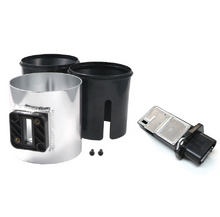Sorry, I should have been more specific and said MAF sensor "attached" to the up pipe, not in it. Unless I understood you wrong? I understand the up pipe goes from the intercooler to the throttle body.
Ok, so what I've been learning, cold is better, but not at the expense of added tubing and bends, better off by bigger intercooler, or liquid cooled, or the other ways in the link Jerryl provided. Reducing the drive pressure, and if I understand that right, is to get the turbo as close to an ideal ratio of 1 to 1, every turn for exhaust equals a turn off intake air? so a more free flowing exhaust like I plan on getting should help, ease the exhaust side of the turbo.
Nigel the picture of the pipe flow chart I don't understand, but I understood most of what you wrote under it except for, "If there was no friction between the air and the pipe as long as the velocity remained roughly 40% of sonic". What does the "as long as the velocity remained roughly 40% if sonic" mean? I know Sonic velocity is the speed of sound, but I don't understand what that had to do with it? Also when you talk about not needing more then a 3" intake unless you're moving a shit ton of air. So a 3" pipe would be fine, since especially what I forgot about, even though an LS1 MAF sensor is 3.5" in diameter, its flow is still not equal to a 3" pipe, somewhere about 80% of it? I see some of the other guys are talking about their 4" pipe with the ls7 sensor, at what point do you know your moving a shit ton? I mean, I know you are correct, I'm far from anything they got going on, I'm just curious when a guy would know? Would it hurt if I was able to add a setup like Rodruckus had pictured?
Speaking of which, Rodruckus i think this is similar to what you were showing and describing, although there were several other versions on this site as well

100mm 4" Mass Air Flow Sensor w/ Blade Style MAF, Hawks
100mm 4" Mass Air Flow Sensor with Blade Style MAFwww.hawksmotorsports.com
JM, I do not, I am planning on getting the Scanmaster G along with the ALDLDROID app within a few weeks. I mistakenly thought I had not modified my car enough to get it.
My. Spool, you wrote "exactly!you can also make 9 sec passes on a stock maf with 1 screen removed." Just curious, but given that same vehicle, if it had a larger intake would it be running faster?
-Rob
I actually should have stated that if the pressure drop is 40% then the formula I posted it is not accurate for compressible flow(my mistake), what the fraction of sonic velocity is I don't know off the top of my head, but the point would be the same.
The formula is for incompressible flow, but remains accurate for pressure drops less than 10% for compressible flow and can be used to approximate up to 40% pressure drop for compressible flow.
So long as the pressure drop is reasonable, which in the case of a good aluminum maf pipe you would have to really be moving some air for that not to be the case, you will be able to recover a good amount of the velocity as pressure. I would be surprised if the pressure drop in a 3 in aluminum inlet pipe was more than 1/2 to 1 psi at flows up to 60 to 70 lb/min, and most of the velocity would be recoverable.
Once compressibility comes into play, at higher fractions of sonic velocity or a high friction factor you will start to dramatically increase your losses. The stock corrugated hose was definitely a restriction.
